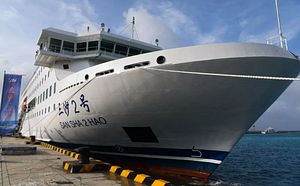News that China launched a new supply and transport vessel this summer for service in the South China Sea has prompted analysis that the ship will be used to fortify and strengthen China’s militarized island bases. But, while the ship will likely provide some military logistics, it appears to be a primarily civilian vessel and lacks the capacity to sustain China’s island bases in a conflict.
In August, Xinhua reported the Sansha No. 2’s maiden voyage from Hainan Island to Woody Island.
The implication of Xinhua’s report is that the Sansha No. 2 will primarily serve the seat of Sansha City on Woody Island. Since the vessel has the range to cover the entire South China Sea and Sansha city administers all of the disputed island chains that China claims, including the heavily militarized Spratly Islands, it would likely provide logistical services beyond the Paracel Islands in the north of the South China Sea as well.
A favorite maxim among military planners is that amateurs study tactics but professionals study logistics because even the most innovative plans will fail if a country cannot keep its military adequately supplied. For this reason, news of the Sansha No. 2 has caused concern among observers who worry it will provide China with major new advantages over other claimants in the region.
Analysis published this month in Voice of America added additional reporting, that the vessel will provide both civil and military logistics support and that Sansha No. 2 will be joined by a third transport vessel soon as well. Military experts speaking to VOA said the ship will likely take ammunition and other stores to China’s military outposts and will provide a major advantage over other claimants in the region who have less logistical capacity to support their island outposts. However, China’s island construction dwarfs all other claimant in the region and likely have much greater logistical needs.
But the Sansha No. 2 and its sister ships are civilian vessels and would not necessarily be useful keeping China’s militarized islands supplied in the event of a conflict. The analysts speaking to VOA characterize the Sansha No. 2 as “large,” but it is quite modest in the context of military supply ships.
According to Xinhua, the Sansha No.2 is 420 feet long and displaces 8,000 tons, which is smaller than a U.S. Navy destroyer, which are over 500 feet long and displace about 9,000 tons. For comparison, the general cargo ships that the U.S. Navy relies on to keep its fleet supplied displace over 40,000 tons.
The more significant vessels to watch in the South China Sea are the PLA Navy’s supply ships. In wartime, the China’s Type 904 general stores ships, which are twice the size of the Sansha No. 2, would likely take the lead in keeping China’s South China Sea bases supplied. The PLA Navy operates five of the logistics vessels in its South Sea Fleet and is outfitting a sixth. If those start to move, or if China constructs many more, it would be a more important indicator of Chinese operations and intentions in the region.

































